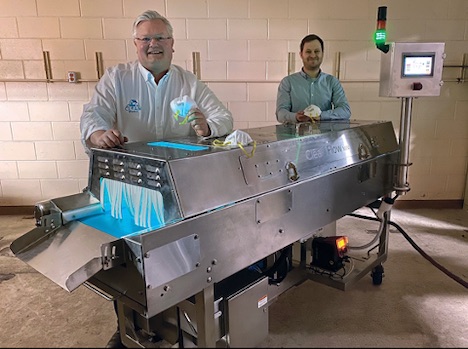Paul Moyer turned to science for help when a listeria outbreak threatened his livelihood five years ago.
The founder of Moyer’s Apple Products in Beamsville was concerned consumers would fear his candy apples after a similar American product sickened 35 people and was linked to seven deaths in the U.S.
So Moyer ran with research conducted at University of Guelph that found combining hydrogen peroxide, ozone and ultraviolet light killed virtually 100 per cent of listeria pathogens — and other illness-causing bacteria and viruses on food.
Moyer set to work with fellow Beamsville business owners Mark VanderVeen and Amber Gulbis of Court Holdings. Together they established a company called Clean Works and built a machine to sanitize fruits and vegetables with a waterless, ozone-based treatment that’s being used today by big players, including the companies that supply sliced fruit and grapes for Starbucks’ packaged lunches and Subway.
Now the trio’s invention is poised to help in the fight against COVID-19 by sanitizing personal protective equipment (PPE) worn by health-care workers on the front lines of the pandemic.
“We did this to keep food safe from pathogens and by hook or by crook, it works on the immediate situation in the world right now,” Moyer said. “It’s turned into something greater. We’re trying to do the right thing and have been. It’s passion-based as much as science-based.”
Shortages of PPE are a concern as Canadian hospitals prepare for a surge of COVID-19 cases in days and weeks ahead. Experts say supply chains are overwhelmed and some hospitals, including in Ontario, have asked staff to reuse protective gear to extend the supply. But reusing PPE, including masks, means an increased risk of infection.
The Clean Works’ Clean Flow machine, which resembles a large stainless steel barbecue, can sanitize as many as 1,200 masks an hour, destroying up to 99.99 per cent of pathogens on surfaces, including N95 masks, in the process.
A conveyor moves the PPE through a chamber in the Clean Flow machine where hydrogen peroxide mist is applied. Ultraviolet light turns the hydrogen peroxide, cited by Health Canada as an effective disinfectant against COVID-19, and high concentrations of ozone into free radicals that attack and kill “enveloped viruses,” the class of pathogens to which COVID-19 belongs.
The original research found the system, called advanced oxidative process, is three times more powerful than bleach at cleaning and disinfecting.
Clean Works is building four machines for use in the fight against COVID-19, pending testing by the National Research Council (NRC) for the deployment of the technology to hospitals. But the company is ramping up to build a machine a day, designed to be easily wheeled into hospitals and nursing homes. In a few months, they could come off the assembly line much faster, Moyer said.
“This technology was born out of making Niagara’s food safer but it can help people around the world in a totally different way than was intended,” he said.
John Martinovic, an industrial technology adviser with the NRC, couldn’t comment on testing specifics or the NRC’s findings so far, citing client confidentiality.
“Suffice to say that we are working every avenue available to us to help them advance this technology in application to the COVID-19 crisis,” Martinovic wrote in an email.
Credit for the research that inspired it all goes to Keith Warriner, a food scientist at University of Guelph.
Warriner began looking for solutions to food-borne illnesses after a rising number of produce contamination cases pointed to current methods of washing harvests at the source being ineffective at protecting consumers against potentially deadly pathogens.
“We discovered you can wash all you like but washing isn’t going to get the bacteria inside,” Warriner said.
Unlike other disinfectants such as bleach, the advanced oxidative process doesn’t leave a residue, Warriner said, making PPE as much as food the ideal application for the technology.
“It does what it needs to do,” he said. “It doesn’t affect the surface and it doesn’t leave any byproducts behind.”
Warriner, who said his research existed only as published papers before Moyer came to him for help with his candy apples, admits to getting emotional when he thinks about his findings being used to fight a global pandemic.
“It all comes down to when you can see your research being used in actual action,” Warriner said. “In COVID-19, if you feel it can help keep front-line workers from getting infected, that’s much bigger than any paper published in Nature.”
Originally posted to: https://www.stcatharinesstandard.ca/life/food-wine/2020/04/07/eating-niagara-from-candy-apples-to-covid-19-beamsville-company-s-technology-poised-to-help-in-pandemic.html

